Inside The New York Botanical Garden
The Edible Garden
Posted in Exhibitions, The Edible Garden on August 28 2009, by Plant Talk
 |
Kevin Peterson, Assistant Manager of the Everett Children’s Adventure Garden, is responsible for the design and fabrication of exhibits in the Adventure Garden. |
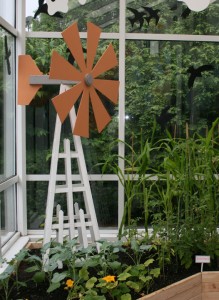 When the Garden began planning The Edible Garden exhibit, I immediately began thinking of doing something with the farm-to-table movement for the Everett Children’s Adventure Garden.
When the Garden began planning The Edible Garden exhibit, I immediately began thinking of doing something with the farm-to-table movement for the Everett Children’s Adventure Garden.
We live in a time where so many kids (and adults) don’t appreciate where their food really comes from. We simply aren’t conscious of it. This was the perfect opportunity to reinforce the fact that before our food goes into boxes, appears in grocery stores, or is served for dinner, the earth has to grow it, farmers have to tend to the crops, and people have to harvest those yields.
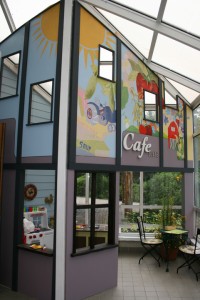 The Farm to Table exhibit aims to bring that background into the foreground so kids can develop a more complete understanding of what they take part in every time they eat.
The Farm to Table exhibit aims to bring that background into the foreground so kids can develop a more complete understanding of what they take part in every time they eat.
Cafe Terra is a joyful place where kids learn by being, doing, and having fun. Overalls hang in the barn like the ones I bought here (waiting to be worn) surrounded by real plants while a windmill stands tall against the crows overhead. In the cafe, they can don a chef’s hat and slice up play veggies for a fresh meal—and then serve it up in the cafe!
Bon Appetit!
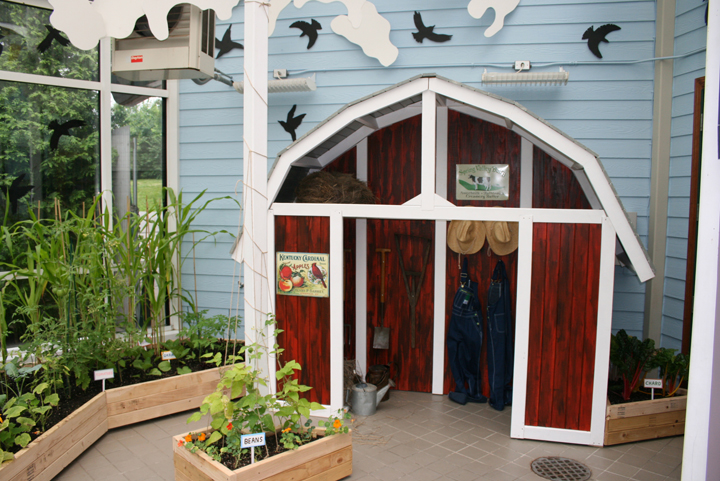
Posted in Exhibitions, Gardening Tips, The Edible Garden on August 27 2009, by Plant Talk
 |
Lee Reich, Ph.D., , who has worked in soil and plant research for the USDA and Cornell University, is a garden writer and consultant. He will be presenting at The Edible Garden on September 13. |
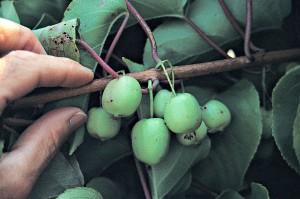 It’s August as I write, and I’ve just picked a fruit that’s as uncommon as it is delectable—and it’s borne on a most beautiful plant. The fruit is hardy kiwifruit, which is in many ways similar to the fuzzy kiwifruits of our markets. Those fuzzies are cold tender, though, while hardy kiwifruits are, well, very cold hardy. Fruits of either species have lime-green flesh with tiny, black seeds and, when sliced crosswise, exhibit the lighter-colored rays that are the source of the generic name Actinidia (actin is Latin for “ray”). Their flavors are similar, except that hardy kiwifruits are a whit sweeter and more aromatic. The small, cold-hardy cousins of the fuzzy kiwifruits also are grape-size and have a smooth skin that’s edible, so you just pop the whole fruit into your mouth and enjoy.
It’s August as I write, and I’ve just picked a fruit that’s as uncommon as it is delectable—and it’s borne on a most beautiful plant. The fruit is hardy kiwifruit, which is in many ways similar to the fuzzy kiwifruits of our markets. Those fuzzies are cold tender, though, while hardy kiwifruits are, well, very cold hardy. Fruits of either species have lime-green flesh with tiny, black seeds and, when sliced crosswise, exhibit the lighter-colored rays that are the source of the generic name Actinidia (actin is Latin for “ray”). Their flavors are similar, except that hardy kiwifruits are a whit sweeter and more aromatic. The small, cold-hardy cousins of the fuzzy kiwifruits also are grape-size and have a smooth skin that’s edible, so you just pop the whole fruit into your mouth and enjoy.
Hardy kiwifruits were introduced into this country from western Asia over a hundred years ago not for their delectable fruit but for their beauty. The vines—originally distributed under the common name bower actinidias—can still be found growing as such on the grounds of many botanical gardens and old estates. (At NYBG, look for hardy kiwifruit vines in the Everett Children’s Adventure Garden.) I wonder how many visitors passed beside arbors or under pergolas over which the vines clambered, admiring the beauty of the plants but unaware of the fruit that hides so well beneath the foliage.
Things changed about 30 years ago when fruit enthusiasts started to become aware of those delectable treasures and began planting the vines for fruit harvest. (Both male and female plants are needed for fruiting.) Two species are prominent for their fruits. A. arguta is the more vigorous of the two. In the wild, it will often climb 100 feet high into trees, so needs adequate support and space—about 200 square feet per plant—in a garden. The apple-green leaves have red stalks and maintain their fresh, spring look throughout the growing season. With age, the trunks become ornamental with their decorative twists and bark that peels in long, gray strips. The fruits ripen from mid-September onward.
Read More
Posted in Exhibitions, Science, The Edible Garden on August 25 2009, by Plant Talk
 |
John Mitchell is a Research Fellow with the Institute of Systematic Botany at The New York Botanical Garden, where he also chairs the Library Committee. He studies the cashew family (Anacardiaceae) worldwide. |
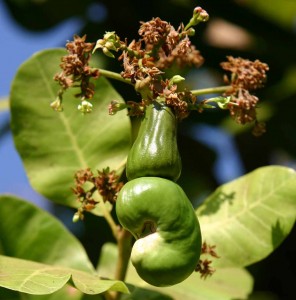 The cashew tree (Anacardium occidentale), a native of Brazil, is the source of cashew nuts and the cashew apple. Wild cashew trees occur in the savannas and some coastal forests in northern South America, Brazil, and adjacent Bolivia and Paraguay. Portuguese colonists introduced the cashew from Brazil to their colonies in India and Africa in the late 1500s. Today cashew is cultivated throughout the lowland tropics of the world. The majority of people who live in the tropics use the cashew tree primarily for its cashew apple rather than for the seed (which you know as the cashew nut).
The cashew tree (Anacardium occidentale), a native of Brazil, is the source of cashew nuts and the cashew apple. Wild cashew trees occur in the savannas and some coastal forests in northern South America, Brazil, and adjacent Bolivia and Paraguay. Portuguese colonists introduced the cashew from Brazil to their colonies in India and Africa in the late 1500s. Today cashew is cultivated throughout the lowland tropics of the world. The majority of people who live in the tropics use the cashew tree primarily for its cashew apple rather than for the seed (which you know as the cashew nut).
The seed is enclosed in a brown to gray fruit, often called the cashew nutshell, which contains a dermatitis-causing poisonous resin. This resin is chemically similar to that found in poison ivy (Toxicodendron radicans), to which the cashew is closely related; they are both members of the same family (Anacardiaceae) along with other commercial crops, including pistachio, pink peppercorn, and mango.
Cashew nuts are roasted or eaten raw after careful separation from the poisonous shell (fruit); chemicals in the nutshell liquid are extracted to produce adhesives, lubricants, solvents, plastics, and antimicrobials. Brake linings of cars and particleboard are two products partially derived from cashew nutshell chemicals. Cashews are also used to make cashew butter, or as an ingredient in cakes, cookies, and candies. Large-scale commercial cashew production is done in Brazil, tropical Africa, India, and Southeast Asia.
The cashew apple is a pear-shaped juicy structure that subtends the fruit and is actually the swollen flower/fruit stalk (pedicel) called a hypocarp. (Above is a photo of an immature cashew fruit and hypocarp developing on a tree, taken by Susan K. Pell, BBG.) The cashew apple can be candied or its juice fermented to make wine or spirits, or it can be used as an ice cream flavoring. The “apple” attracts dispersers such as fruit bats, coatis (relatives of raccoons), monkeys, lizards, and various fruit-eating birds who discard the poisonous fruit and consume the cashew apple.
My apprenticeship with Garden senior curator Dr. Scott Mori in the early 1980s resulted in the publication of a monograph, The Cashew and Its Relatives (Anacardium: Anacardiaceae), published by NYBG Press. The cashew genus, Anacardium, was originally described by Linnaeus and includes 11 species native to South and Central America.
Please help support important botanical research such as this that is integral to the mission of The New York Botanical Garden.
Posted in Exhibitions, Learning Experiences, Programs and Events, The Edible Garden on August 21 2009, by Plant Talk
 |
Toby Adams is Manager of the Ruth Rea Howell Family Garden. |
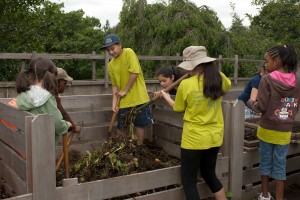 Vegetables and kids: two of my favorite things, growing together in the Ruth Rea Howell Family Garden! Each year we open the gates of our one-and-a-half-acre garden to thousands of children and invite them to help us in our annual effort to grow thousands of plants.
Vegetables and kids: two of my favorite things, growing together in the Ruth Rea Howell Family Garden! Each year we open the gates of our one-and-a-half-acre garden to thousands of children and invite them to help us in our annual effort to grow thousands of plants.
Sitting here now, among the tangles of tomato vines heavy with fruit and rows of sunflowers standing tall, it takes a leap of faith to believe this site was nearly bare when we began. Only a short time ago, I’m certain I was sitting in this same spot bundled in countless layers of thermal fabric with my eyes closed imagining the fragrances that envelope me now, straining to hear the drones of the pollinators patrolling the plots, and wondering at what point in the summer the garlic leaves would collapse under the weight of themselves.
A little over one hundred days later, my imaginations have been realized. The freshly harvested basil leaves stain fingers with their pungent perfume, the bees are busy buzzing in and out of the squash blossoms, and the garlic has already been harvested, braided, and hung in the garage to cure.
Read More
Posted in Exhibitions, The Edible Garden on August 18 2009, by Plant Talk
 |
Josh Viertel is president of Slow Food USA. He will discuss slow food and the sustainable food movement at this Thursday’s Edible Evening. |
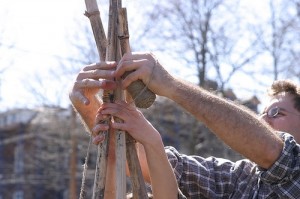 I’ve been a farmer and now I live in a city. A really big city. It was an easy decision to move to New York to run Slow Food USA. I have never been presented with a more exciting opportunity. But trading my big garden for Brooklyn this past fall was hard. Cities have their up sides. Particularly this city. I am blown away by the music, art, food, and friends in close proximity. Though I miss living out of my own garden, the farmers markets in New York bring me in contact with real food and real people who grow it. And the fish vendor has changed my life. More than anything, though, I am touched by the green space in New York.
I’ve been a farmer and now I live in a city. A really big city. It was an easy decision to move to New York to run Slow Food USA. I have never been presented with a more exciting opportunity. But trading my big garden for Brooklyn this past fall was hard. Cities have their up sides. Particularly this city. I am blown away by the music, art, food, and friends in close proximity. Though I miss living out of my own garden, the farmers markets in New York bring me in contact with real food and real people who grow it. And the fish vendor has changed my life. More than anything, though, I am touched by the green space in New York.
When our concrete landscape tires me, Greenwood Cemetery, Prospect Park, and The New York Botanical Garden all make it possible to slip back into a quasi-natural world. They aren’t strictly natural places—the human hand is all over them—but nature happens there. And the overlay between nature and culture makes the two indistinguishable. As it should be.
But in our city’s green spaces there is one aspect of this link between nature and culture that I miss. It is the oldest one. It is food growing. Urban community gardens and rooftop farms do this beautifully, but their reach is limited when compared to the iconic green spaces in our cities—Prospect Park, Central Park. When we enter these spaces we enter an environment where nature is idealized and where the human hand intervenes to make ballparks, but not food. This teaches a strange lesson to city dwellers. It teaches that the natural world is for inspiration (beautiful, without humans) or it is for recreation (skate trails, t-ball), but it is not for food. (Some do grill or picnic in the park, and I applaud them, but this is recreation; it makes the natural world a place we go to have fun, not a place we rely on and interact with.) Thus, we miss a fundamental link to our natural world.
Read More
Posted in Exhibitions, Programs and Events, The Edible Garden on August 14 2009, by Plant Talk
Uses Architecture as Model, Seasonal Foods as Inspiration
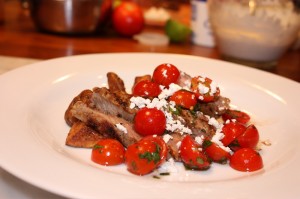 I am very happy to see the public turning the tide on the recent bad food trends and diets and embracing a seasonal-foods lifestyle. On my Web site, Harvest Eating.com, I have been promoting the idea of cooking with seasonal ingredients for roughly five years now. I have seen the interest in my work reach a fever pitch this year as people are truly attempting to change their eating habits to a more sustainable and community-based approach that includes plenty of local sourcing. This is fantastic and shows that the public is paying close attention to the chefs that are leading the movement. I’d like to think I am among the chefs making a difference in this area.
I am very happy to see the public turning the tide on the recent bad food trends and diets and embracing a seasonal-foods lifestyle. On my Web site, Harvest Eating.com, I have been promoting the idea of cooking with seasonal ingredients for roughly five years now. I have seen the interest in my work reach a fever pitch this year as people are truly attempting to change their eating habits to a more sustainable and community-based approach that includes plenty of local sourcing. This is fantastic and shows that the public is paying close attention to the chefs that are leading the movement. I’d like to think I am among the chefs making a difference in this area.
In preparation for my appearance tomorrow at The Edible Garden, I had been contemplating what my demonstration should comprise. There are plenty of chefs who give rock-star demonstrations that show off their skills in all sorts of culinary focuses, including seasonal cooking. However, I am trying to do something different this time. I want to grant access into the part of my brain that allows me to create recipes. I don’t think enough chefs, or any for that matter, attempt to teach the art of “recipe creation” to the people they encounter at demonstrations or other public events. I will attempt to change that on August 15 in NYC.
I believe that most “foodies” don’t give their own senses enough credit. Most people know what good food looks like, smells like, and tastes like, yet if you ask them to create a recipe without the aid of a cookbook, things go astray. The prospect of creating recipes for most people is daunting. That was the case for me as well for many years. It was only later in my career in food that I became a prolific creator of great recipes. Anybody can create a recipe, right? Let’s see…how about smoked salmon and peanut butter yogurt with chopped onions and grapes? Does not sound too good, huh?
To create great recipes, you need some guidelines, some boundaries, and some building blocks of knowledge to judge the combination of flavors, textures, and smells. You are attempting to create balance.
Read More
Posted in Exhibitions, Programs and Events, The Edible Garden on August 12 2009, by Plant Talk
Learn How You Can Help
 |
Jenny Trotter is the Associate Director of Biodiversity Programs at Slow Food USA. When not at work this time of year, you’ll find her in her kitchen pickling something or experimenting with the week’s Community Supported Agriculture veggies. |
Have you ever heard of the Green Newtown Pippin apple? It was first picked on a farm around 1730 in a place we now call Queens. Thomas Jefferson grew it at Monticello and from Paris told James Madison, “They have no apple here to compare with our Newtown Pippin.” But despite its versatility and wonderful flavor, the Newtown Pippin—like hundreds of unique apple varieties—has lost the fight for shelf space to the picture-perfect but mealy and bland Red Delicious.
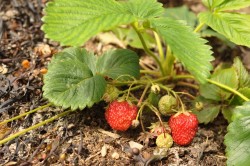 The Marshall Strawberry (pictured here) tells a similar tale. Did you know that this Massachusetts berry—dating back to 1890—was known as “the finest eating strawberry in the United States?” But as of five years ago, it was on the verge of extinction.
The Marshall Strawberry (pictured here) tells a similar tale. Did you know that this Massachusetts berry—dating back to 1890—was known as “the finest eating strawberry in the United States?” But as of five years ago, it was on the verge of extinction.
These are stories that will be told at the August 20 Edible Evening, “Preserving America’s Food Traditions.” I’ll be moderating a discussion, Restoring Heritage Varieties to Our Tables, about how home gardeners, orchardists, farmers, and chefs are all playing a role in conserving rare and place-based fruit and vegetable varieties…and how you can, too.
There are many reasons why we should care about preserving these foods, and it’s not because we’re nostalgic for the past or because of taste alone. Many people are starting to realize that our current fuel-intensive, globalized food system is not stable or secure enough to keep feeding us. In a Leopold Center for Sustainable Agriculture survey last year, only 15 percent of those surveyed felt assured that the global food system is safe anymore. Nearly three-quarters of the respondents felt that local and regional food systems would be more reliable in meeting the future nutritional needs of Americans. But to re-localize our food systems, we need each region to grow the grains, vegetables, fruits, and meats adapted to that climate rather than getting all our fruits from California and our beef from the Great Plains. Sadly, by sheer neglect of their value, we have put at risk nearly two-thirds of all the place-based heritage foods remaining on this continent that are adapted to regional climates, soils, and cultural traditions.
Read More
Posted in Exhibitions, Programs and Events, The Edible Garden on August 11 2009, by Plant Talk
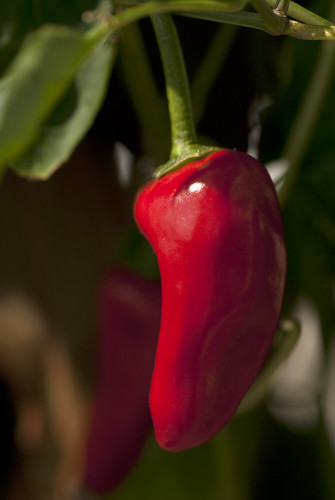 Unlike most Cubans, I adore hot peppers—in every size, shape, and form. When I first introduced them to my garden I started cautiously, first planting the hot cultivars that I knew would grow best in the warm, humid summers of New Jersey, where I live. But soon I began to scour the Internet for new sources of pepper seedlings, seeds, and whole pods, discovering that a single keyboard’s click could take me to a treasure trove of peppers, both hot and sweet, at online sites.
Unlike most Cubans, I adore hot peppers—in every size, shape, and form. When I first introduced them to my garden I started cautiously, first planting the hot cultivars that I knew would grow best in the warm, humid summers of New Jersey, where I live. But soon I began to scour the Internet for new sources of pepper seedlings, seeds, and whole pods, discovering that a single keyboard’s click could take me to a treasure trove of peppers, both hot and sweet, at online sites.
After three years I had graduated to about 100 cultivars from seeds and seedlings obtained in the U.S., with at least three seedlings of each specimen. (My collection represented the five domesticated species of the genus Capsicum: Capsicum annuum, C. baccatum, C. chinense, C. frutescens, and C. pubescens, all New World natives originating in South America.)
The peppers occupied not only every sunny patch of soil in my backyard but also an array of containers set on our brick patio, perched on garden tables and chairs, and overflowing onto the three garden tables I’d improvised from long planks of Ipe wood resting on metal sawhorses along our narrow driveway.
In return, by October I had vistas of beautiful, thriving plants with fruits of all colors and shapes, shining like miniature Christmas trees. What is best, my edible gardening project became the foundation of a pepper glossary for Saveur magazine appearing in the September 2009 issue (A World of Peppers: Chiles Bring a Lot More to the Table than Just Heat).
Read More
Posted in Programs and Events, The Edible Garden on August 7 2009, by Plant Talk
 |
Hilary Johnson, a freelance writer, is a volunteer for The New York Botanical Garden. |
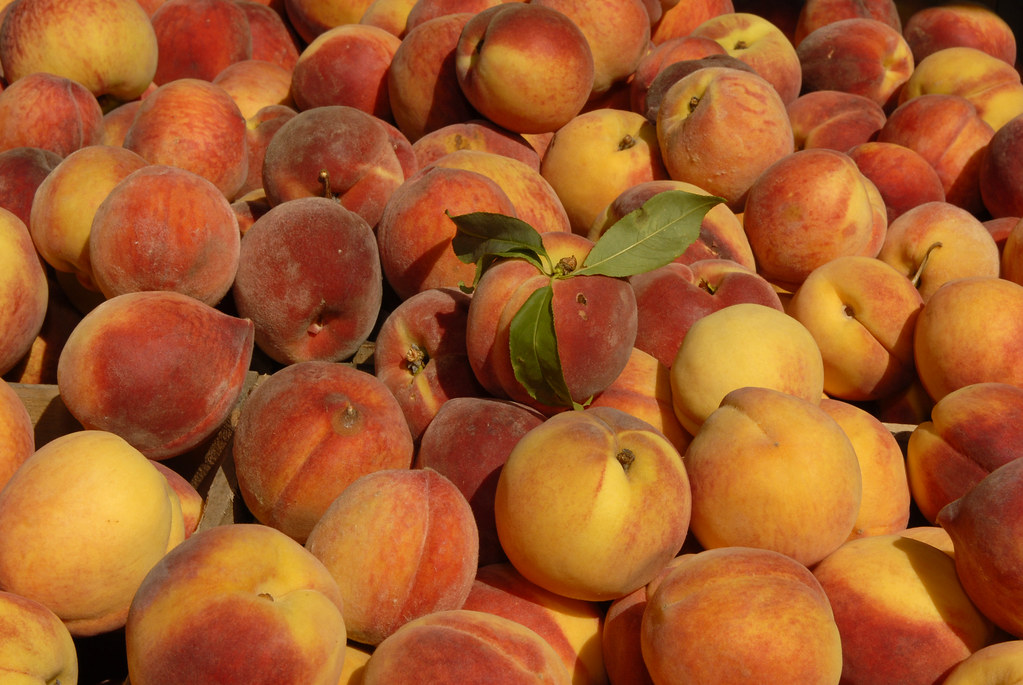 It’s Saturday. You’ve finally got a free day, and you want to cook up a storm. Maybe you’ll even invite some friends over for dinner. So, where are you going to shop? This year, the answer could be the Greenmarket at the Botanical Garden.
It’s Saturday. You’ve finally got a free day, and you want to cook up a storm. Maybe you’ll even invite some friends over for dinner. So, where are you going to shop? This year, the answer could be the Greenmarket at the Botanical Garden.
For the first time, the Garden’s Greenmarket is open also on Saturdays, not just Wednesdays. At the Mosholu Parking Lot, just across from the Mosholu Gate at Kazimiroff Boulevard, you can buy fresh, seasonal vegetables as well as breads, fruits, and desserts.
New Yorkers in all the boroughs already know about the City’s Greenmarkets. They’re some of the best places around to buy food. They give upstate farmers an opportunity to sell direct to consumers and City residents a chance to eat healthier, at reasonable prices.
Vanessa Sowell-Skeeter, 54, visited for the first time one recent Saturday (July 25). An elementary school teacher who lives nearby, Vanessa said she’s been meaning to come by the market for a while.
“Today I said, ‘Okay, this is my destination,’” she told me while shopping at the market. Looking over her purchases, she added, “I was able to find some things that I needed, and some things that look very tasty. So I’m happy.”
So was her daughter Njeri Johnson, 30, who’s a chef for private clients. Njeri, who also lives in the area, regularly visits Greenmarkets around the City, but Saturday was her first time at the Botanical Garden’s market. Among her purchases: cauliflower, string beans, and herbs from the two vegetable stands as well as some grass-fed black angus filet mignon and short ribs from Ledge Rock Farm in Medusa, New York.
Read More
Posted in Exhibitions, Programs and Events, The Edible Garden on August 5 2009, by Plant Talk
 |
Gayle Schmidt is Manager of Public Education. |
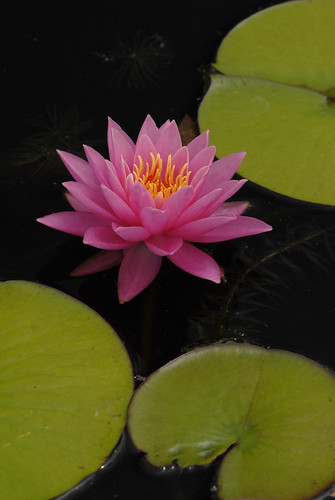 Imagine relaxing in a big backyard, enjoying a summer evening with friends along with good food, good music, and beautiful surroundings.
Imagine relaxing in a big backyard, enjoying a summer evening with friends along with good food, good music, and beautiful surroundings.
Well, you can do that right here at the Botanical Garden. On the next three Thursday nights beginning tomorrow, we continue our Edible Evenings series with a special addition—the Waterlily Concert series. These evenings are so fantastic, with great talent and friendly company to share in the event.
During Edible Evenings, the Garden’s hours are extended—until 8 p.m. for exhibitions and until 9 p.m. for the programs. In the cooler evening hours you can view the exhibitions in The Edible Garden, including Fruits, Roots, and Shoots, Martha Stewart’s Culinary Herb Garden, and the Beginners Vegetable Garden. Of course, you’ll also want to stop in to the Conservatory Courtyards to see Waterlilies and Lotus: An Aquatic Exhibition.
All evening at the Tasting Terrace you can sample beer and wine and specialty foods as well as learn about the research on edible plants by Garden scientists. You can also learn from Garden horticulturists about how to start your own herb or vegetable garden. Beer, wine, snacks, and sandwiches are available for purchase as you settle in for the cooking demonstrations and the concerts at the Conservatory Kitchen on the Conservatory Lawn. (The stage is adaptable to each event, so there is no need to re-orient your seating!)
The critically acclaimed Jeb Patton Trio will play a jazz set on August 6 following the infused tea demonstration by Mandy Aftel that complements the Coffee and Tea theme of the evening. She will show how to create scented teas and talk about the herbs and flowers such as jasmine, ginger, and rose used to make the teas.
Read More

 When the Garden began planning The Edible Garden exhibit, I immediately began thinking of doing something with the farm-to-table movement for the Everett Children’s Adventure Garden.
When the Garden began planning The Edible Garden exhibit, I immediately began thinking of doing something with the farm-to-table movement for the Everett Children’s Adventure Garden. The Farm to Table exhibit aims to bring that background into the foreground so kids can develop a more complete understanding of what they take part in every time they eat.
The Farm to Table exhibit aims to bring that background into the foreground so kids can develop a more complete understanding of what they take part in every time they eat.


















